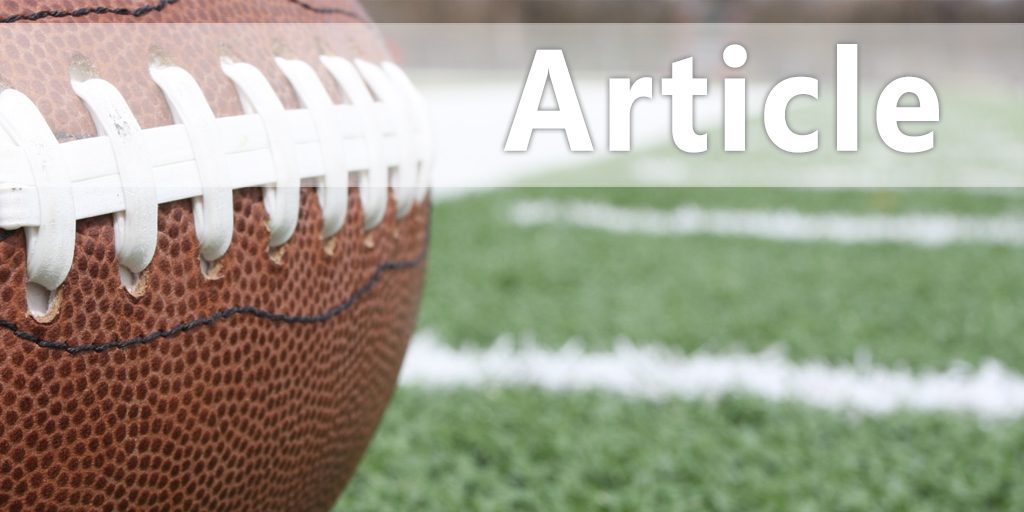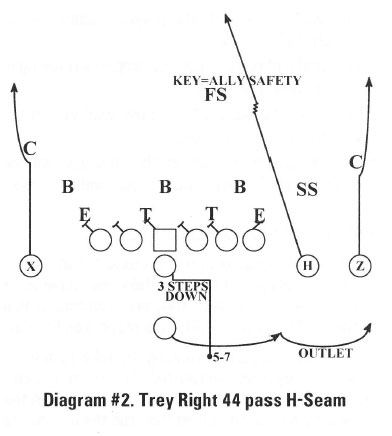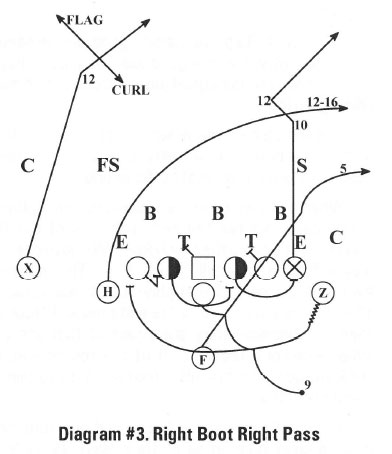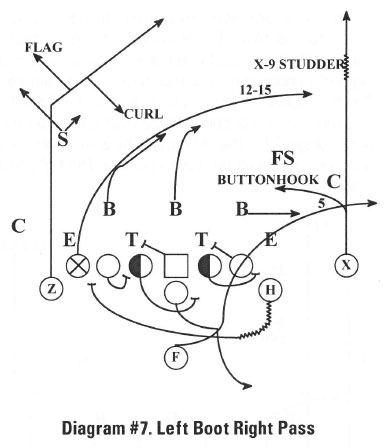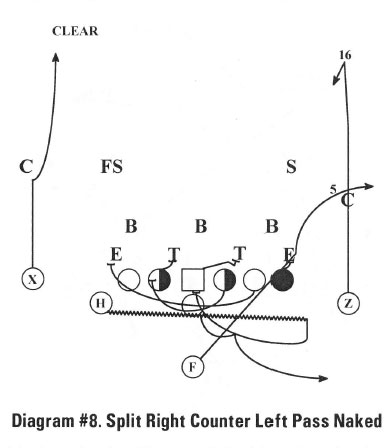| Play-Action Passes from our Best Plays
In my first year, we were 13-1 and defeated Mt. View High School in the finals. In my second year, we ended up getting beat by Brophy College Preparatory in a monsoon that night. That was not the reason we lost, however. We ended up with a 12-1 record. The next morning I woke up, looked into the mirror, and asked myself this question: What am I not doing right? I was about as miserable as I could be. We were 12-1 for the year and I was miserable. Something is wrong with that. I knew it is not about winning. I was not happy with the direction of our program in terms of how our kids were reacting and overall how we were perceived in the state. I just did not like the status of our football team. I decided we needed to make some changes. I told my wife I was going to go talk with our principal, Dr. Fred DePrez. I was prepared to let him know there had to be some changes made in our program philosophywise or I would not mind resigning as head coach. I had no problem with that move. Dr. DePrez told me to make the changes I needed to make in the program. At that point, I knew this was the place I wanted to be. I came into a great program and I did not want to rock the boat, but it did not feel as if it was my program. So after that second year, we made some changes. For time's sake I will not get into all of the changes. As a head coach, it has to be your program. You have to feel comfortable with the program. I heard Bret Bielema of the University of Wisconsin-Madison lecture at the AFCA Convention this year. What he said holds truth for what we are doing at Hamilton High School. This is what I took from that lecture. First, you must have a loyal coaching staff. You must have assistants that believe in what you believe in. If you do not have coaches that believe in what you believe in, they need to go somewhere else to coach. I am sorry; but, if they do not believe in what you believe in, you are going to have coaches stabbing you in the back left and right. We have 35 guys in our program from the freshman level to the varsity. They are either volunteers or paid coaches. We have 24 varsity coaches and we are all on the same page. Our kids get coaching. All of these 35 guys are former players or state championship coaches, but they all check their egos at the door, including myself. I am no better than the other coaches, except I have to lay down the law and define the expectations that I have. Everyone is on the same page. I am not saying that we all agree on everything. We made an agreement a few years ago that if we have a problem with one another, we would not discuss the problem on the field. We agreed to come in after practice and talk about it. When we leave the locker room it is over and done. What we have now is a situation where we can work together to better our program. When we come into our Sunday meeting, we break down the game films and we make our plans for the week. After that, we are done. There is no griping, moaning, and complaining. When you can reach that level as a head coach or as an assistant coach, you are going to be so much happier as a coach. You can have your say on what we decide to do for each game. We platoon our players. We do not have anyone going both ways. We did have one kid that played both ways. He got an offer to go to Boise State University today. The point I am making is the fact that everyone has a chance to have input in our program. If you feel you do not have an opportunity for input, you need to go somewhere else to coach. Everyone has to accept our rules on this. It may be a scout team coach. We have two young coaches that do our scouting. They put their heart and soul into scouting the opponents. We review where we are as a staff each year. Four weeks ago, we had a four-hour meeting discussing where we are and where we can get better. Anytime you do a lecture it makes you look at what you do well and what you do not do well. Where can you get some ideas that can make your program better? I put together some materials on our play-action passing game. I was at another clinic and I heard a coach talking about their play-action passes. I picked up one point from that lecture that I liked. "Make sure your players are accountable for doing the play-action passes great." I want to get into the philosophy we base our offense on. First, we want to attack the defense. PHILOSOPHY We feel play-action passing is a worthy attack phase of the game. We want you to think it is a running play, but we are going to throw the ball. When we throw the ball, we are going for the home run. We are not going for five yards; we are going for broke. We do have outlet passes depending on what the defense does, but, realistically, we want to go deep against you six or seven times a game. If we can complete three of those deep passes, they can make a difference in the outcome of a game. They could result in three touchdowns in a game and help us win the game. We want to control the situation on offense. We do not want the defense to dictate to us what we can and cannot do on offense. You run what you want to run. If the defense puts nine men in the box, you have to throw the ball to keep them honest. If you have a coach in the press box, make sure that coach knows what is going on in the game. He must know the situation. "What did you see on that play, Coach?" "Well, I saw 11 players on the field." That is not what we want from the coach in the press box. We have special situations we want to know about. If they have an alley player, we want to know that. We believe you must play with a plan. I have a playsheet that I carry with me on the sideline. The coach that calls the plays does not use a playsheet, but he knows the game plan. Each week we want to come up with a plan and coach our quarterback up. All of our position coaches make sure they coach their players up on what is expected and what we must do. The big thing we must improve on is the fake on the play- action pass. We must work on making the play look like a run. We look for big-play opportunities. No question about this. This is a real key. You want to make sure the right personnel is on the field for these big plays. Make sure the players know who should be in the game in the big-play situations. You do not want a third-team player in the game that has to make a big play for you. Coaches must know the situation and they must know what we are trying to accomplish. It is important to use the coach that is in the press box. Use him effectively. Our coaches in the press box give us great information on what is going on in the game. For example, they can let us know what coverage we are seeing and if the safeties are coming up strong to fill for the run. What we look for is if the defense has one safety or two safeties. If the deep safety is cheating over on plays, we are going to try to take away the middle of the field with certain plays. The coaches in the box can be a big help if you use them right. We must coach the play-action passing game. That is what we are doing now. Following are a few points we stress with the players regarding the play-action passing game: • We let the players know how important faking is in the play-action game. One of our sponsors provides us with Gatorade®. We tell our players if they can fake the cameraman out on a play-action pass, they are rewarded with a Gatorade. This is a big deal for our players on film day. We want our backs running the fake to make it look as if they have the football. They do not need a herky-jerky motion on the fake. Have them run the same way as they do when they run the ball on the regular play. When we tell a player he did a good job, we need to tell him why it was a good job. The player may not know why he did a good job. "The coach told me I did a good job." It is the same thing when you tell a player he made a bad play. Tell him why he is sitting on the bench. Let him know what he did wrong. When a player scores a touchdown on a play- action pass, we tell him he is only one of the 11 players that scored the touchdown. We have every player do what we call "touch it up." That means everyone is a part of that play-action touchdown. The other 10 players go to the end zone and "touch them up" because they are a part of that score. When everyone feels a part of the touchdown, I think you get better results. You may want to think about doing that. You must demand the backs and quarterback make a good fake on all of their plays. Don't let them off the hook. You can work on that during the 7-on-7 summer games. Demand good fakes by everyone involved. At this time of the year we have what we call "advisory time" for all of our students. The students get 25 minutes to meet with teachers, to make up tests, etc. I have the quarterbacks come in with me and we have sessions for the quarterbacks. They get on a whiteboard and work on the things related to their position. I do not coach them. I tell them what I want them to do, and they have to describe it on the whiteboard. We make them write the things on the board and we make sure they understand what they are talking about on the situation. We want to make them accountable on game night. We have three days a week where we go on the field. On Monday, we go over everything in the classroom. On Tuesday, we go over what we covered on Monday on the board. We go on the field and run through everything. We get loosened up and then do 7-on-7. On Friday, we are on the field for about one hour and fifteen minutes with the kids. We have two hours a week built into our school day. We lift three times a week. We get enough out of those three days. We do not feel it is how big our players get. If we get a player that is too big, he is not going to be able to move for us in a game. We do a lot of agility drills. We want to make sure we are flexible. If you do not have good hips, you cannot move. THREE TYPES OF PLAY-ACTION FAKES • Quarterback must make it look like the run play. • Quarterback must show the defense the football for a short period of time, then pull it back in, and set up to pass. • The third fake is a fake that quickly shows the football but does not affect the rhythm of a timing pattern. We have run this offense out of the wing-T formation, but we have also run it from the shotgun formation. We have done boot pass out of the shotgun. You can incorporate all of this into your offense. We are under the center 90 percent of the time. LINEMAN KEYS This, however, means that the protection is not as sound as normal protection and can break down at times. I want to put on the film to show you our play- action passes in game situations. I will go fast, but if you want a copy of this disk, drop me a note and I will be glad to send you a copy. If you have questions, I will sit down with you after the film and talk as long as you want. I will tell you, our offensive line was good this year and did a great job of protecting our quarterback. We had one player sign with Auburn University, one with the University of Oregon, one with Fresno State, and two with San Diego State University. They were five good football players. I talked about the veer being one of our best plays. This is the play-action pass against the 4-3 defense (Diagram #1).  We have two X-receivers on the next play. We want to go deep on this play so we slip in a second X-receiver that has some speed. We pull both guards on the play (Diagram #3). The Z back goes in deep motion faking the sweep play. Our fullback is in the flat.
Another play where we use the two X-receivers is in an X cross route. We call it "left boot right pass X cross" (Diagram #4). We have the same action by the backs and both guards are pulling. The X-receiver that is running the crossing route splits seven yards from his tackle. He wants to find the hole behind the safety on the play. 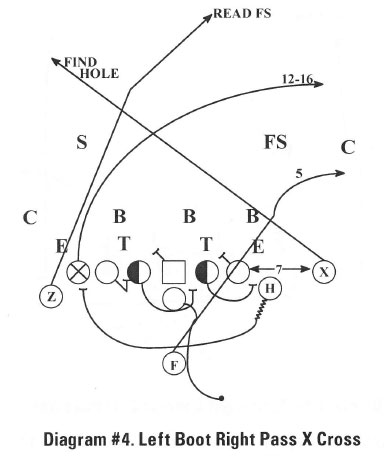 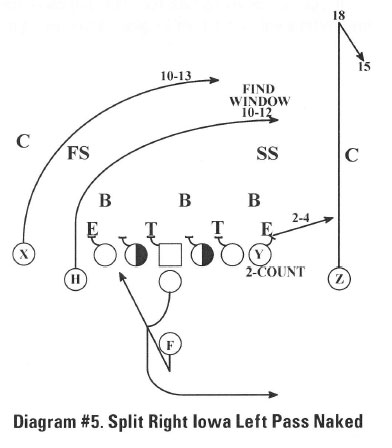 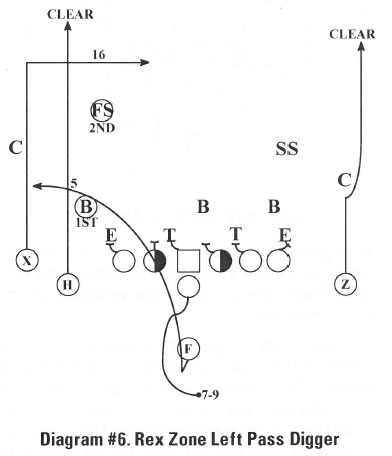 If we see a team that wants to play us with press coverage on the tight end side of the formation, we can run the play-action pass a lot of different ways. We use a second X-end and send him wide to the slot side. He runs a buttonhook route (Diagram #7). The quarterback is reading the Will linebacker. If Will has the X-receiver covered, he can run a deeper route. The quarterback reads the Mike linebacker. If the Mike backer does not go with the other X-receiver, he throws him the ball across the middle. If he does not get the ball, he continues to run a crossing route 12 to 15 yards deep.
The action of the backs is the same. The fullback runs his flat route. The quarterback should be able to find the split end open on the buttonhook or the fullback open in the flat. Here, it was second down and eight to go for the first down, and we were just looking to move the chains. If that backer goes with the fullback, the end sits in the window inside on the buttonhook. We can run a similar play by splitting the X-end and have the H-back go in motion from his wing position. He crosses the center and comes back on a fake over the center. The fullback runs the same route as before (Diagram #8). The guards pull toward the split end. We keep the tight end in to block on the play. The quarterback is looking for the fullback in the flat. When is the best time to throw the play-action pass? It is on first down or on second-and-short. Those are the best downs to hit the long pass. The thing you must be aware of is the fact that in the 7-on-7 games, the time factor is a problem in running play-action passes. If you just want to talk football, you can email me anytime you want. I will be glad to talk with you.
|
|
|
